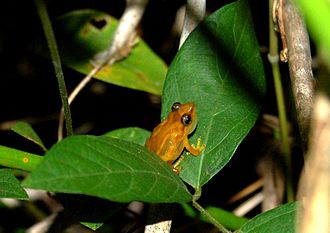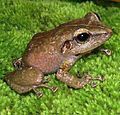Difference between revisions of "AY Honors/Coquí/Answer Key"
m |
m (+ more Coquí answers) |
||
| Line 72: | Line 72: | ||
==10. In what other countries, outside of Puerto Rico, is the coquí found?== <!--T:11--> | ==10. In what other countries, outside of Puerto Rico, is the coquí found?== <!--T:11--> | ||
| − | Colombia, | + | Colombia, Cuba, Guatemala, Dominican Republic, US Virgin Islands, UK Virgin Islands |
==11. Which coquí:== <!--T:12--> | ==11. Which coquí:== <!--T:12--> | ||
| Line 103: | Line 103: | ||
===f. has a color considered black or dark marble?=== <!--T:18--> | ===f. has a color considered black or dark marble?=== <!--T:18--> | ||
The [[w:Web-footed_coqu%C3%AD|web-footed coquí]] (''Eleutherodactylus karlschmidti'') (also known as Karl's robber frog)<br /> | The [[w:Web-footed_coqu%C3%AD|web-footed coquí]] (''Eleutherodactylus karlschmidti'') (also known as Karl's robber frog)<br /> | ||
| − | [[File:5-web-footed coqui.jpg|thumb|left|5-web-footed coquí] | + | [[File:5-web-footed coqui.jpg|thumb|left|5-web-footed coquí]] |
{{clear}} | {{clear}} | ||
| Line 118: | Line 118: | ||
==14. Why should the Puerto Rican coquí be protected?== <!--T:22--> | ==14. Why should the Puerto Rican coquí be protected?== <!--T:22--> | ||
| + | It is our imperative to help protect and conserve the Puerto Rican coquí for the following reasons: | ||
| + | *Aesthetic: its habitats make up an incalculable and valuable resource and provide beauty to the island | ||
| + | *Economical: it brings tourism to the island | ||
| + | *Ethical: we are responsable for making the coquí endangered | ||
| + | *Ecological: it is an important predator to many nocturnal plagues | ||
| + | *Cultural: inside and outside of Puerto Rico, it is a symbol of Puerto Rican culture and its people | ||
==15. What can be done to conserve the coquí?== <!--T:23--> | ==15. What can be done to conserve the coquí?== <!--T:23--> | ||
| + | We can halt [[w:Deforestation|Deforestation]], conserve the [[w:Tropical_rainforest_conservation|rainforest]], develop educational environment programs, reduce pollution, in the air, water, and ground, and help fund research related to the coquí. | ||
==References== <!--T:24--> | ==References== <!--T:24--> | ||
Revision as of 18:40, 18 March 2018
1. To what class does the coquí belong?
2. This class is divided into three orders, Apoda, Caudata, and Anura. The coquí belongs to the Anura order. What other members belong to this order?
Frogs and toads.
3. What member of this class is mentioned in the Bible?
Frogs are mentioned in the Bible, more famously as one of the 10 plagues against the Egyptians, found in Exodus chapter 8. They are also mentioned in Psalms 105:30; and Revelation 16:13.
4. Give the general traits of this class.
They are cold-blooded; their skin is not covered with anything; they are soft and moist (with the exception of Caecilian, which have small scales); they have an aquatic larval stage of development; the young generally undergo metamorphosis from larva with gills to an adult air-breathing form with lungs; they use their skin as a secondary respiratory surface.
5. What characteristics distinguish the coquí from the rest of the amphibians?
An absence of an inter-digital membrane (which means they're not adapted to swimming); the last toe ends in a T shape; it has terrestrial reproduction and direct development, which means they have no tadpole stage, they hatch from eggs as fully formed small frogs.
6. Why is it call the coquí?
The species is named for the loud call the males make at night.
7. What other sound, song, or call, besides "coquí", does the coquí make?
Different coquí make different types of sounds, such as:
"Churi- ki – ki – ki", Red-eyed coquí (Eleutherodactylus antillensis), locally known as coquí churí
"Tic – tic – tic", Grass coquí (Eleutherodactylus brittoni)
"Clicks – clicks", Eneida's coquí (Eleutherodactylus eneidae))
Prolonged and fine whistle, Whistling coquí
A low "chip – chip", Bronze coquí, or Richmond's coquí, (Eleutherodactylus richmondi)
Waterdrops falling, Mona coquí (Eleutherodactylus monensis)
"Tuit – tuit – tuit", Golden coquí (Eleutherodactylus jasperi)
8. What is the purpose of the song of the coquí?
This sound serves two purposes; "CO" serves to repel males and establish territory, while the "KEE" serves to attract females.
9. What is the genus of the species of the Puerto Rican coquí? Give the name of five species and show slides or pictures of them.
THe genus is called Eleutherodactylus; there are several, several species that belong to this genus. Here are just a few examples:
Red-eyed coquí (Eleutherodactylus antillensis)
Dwarf coquí (Eleutherodactylus unicolor)
Spotted chirping frog (Eleutherodactylus guttilatus)
Lesser Antillean whistling frog (Eleutherodactylus johnstonei)
10. In what other countries, outside of Puerto Rico, is the coquí found?
Colombia, Cuba, Guatemala, Dominican Republic, US Virgin Islands, UK Virgin Islands
11. Which coquí:
a. is the largest?
The web-footed coquí (Eleutherodactylus karlschmidti) (also known as Karl's robber frog).
b. is the smallest?
The Plains coquí (Eleutherodactylus juanariveroi)
c. sings "coquí?"
Common coquí (Eleutherodactylus coqui)
Puerto Rican rock frog, locally known as the coquí guajón (Eleutherodactylus cooki)
- Eleutherodactylus portoricensis.jpg
Mountain coquí (also known as upland coquí, Puerto Rican robber frog), (Eleutherodactylus portoricensis)
- Eleutherodactylus wightmanae.jpg
Melodious coquí (Eleutherodactylus wightmanae)
d. has a song similar to the sound of a water drop?
The Mona coquí (Eleutherodactylus monensis)
e. has a song similar to the sound of winding a watch or passing fingernails through the teeth of a comb?
The Dwarf coquí.
(at 0:14 seconds)
f. has a color considered black or dark marble?
The web-footed coquí (Eleutherodactylus karlschmidti) (also known as Karl's robber frog)
g. has the highest frequency of vocalization?
The Plains coquí (Eleutherodactylus juanariveroi)
12. In what part of the world is the coquí considered a plague and how did it arrive there?
THe coquí is considered a plague on the islands of Hawaii. They were brought over by boats that were unloading ornamental plants from Puerto Rico.
13. What is the name of an extinct coquí?
Eneida's coquí (Eleutherodactylus eneidae)), golden coquí (Eleutherodactylus jasperi), and the web-footed coquí (Eleutherodactylus karlschmidti)
14. Why should the Puerto Rican coquí be protected?
It is our imperative to help protect and conserve the Puerto Rican coquí for the following reasons:
- Aesthetic: its habitats make up an incalculable and valuable resource and provide beauty to the island
- Economical: it brings tourism to the island
- Ethical: we are responsable for making the coquí endangered
- Ecological: it is an important predator to many nocturnal plagues
- Cultural: inside and outside of Puerto Rico, it is a symbol of Puerto Rican culture and its people
15. What can be done to conserve the coquí?
We can halt Deforestation, conserve the rainforest, develop educational environment programs, reduce pollution, in the air, water, and ground, and help fund research related to the coquí.











